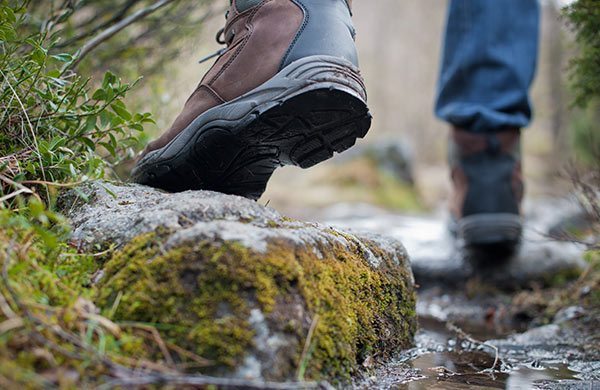Let’s go for a walk. Comfortable boots on? Comfortably covered feet will make a walk in the hills an absolute pleasure. You really won’t notice the great work going on below knee, at your ankles, as you stride along with your walking pal, taking in all the beautiful scenes.
The big but is that, the wrong boots will make you, and everyone else with you, miserable as sin. So, don’t make friends with the hills until you have encased your feet in a fine pair of walking boots.
Selecting the right footwear
Comfort
An absolute must! You won’t wear them otherwise.
Price
Expensive is not always best. Mid-range is better and you’ll be less likely to soldier on with boots that just aren’t right for you.
Style
Walking boots for more than your regular, enjoyable hill walk? – walking the dog, school run, charity walk? Or are you a bit of a fashionista? Synthetic boots coming in multiple colour ranges and styles with decorative touches, if hats what you desire.
Durability
Boots that are up to the job you use them for will last a lot longer.
Material
Leather is durable and stands up to abrasive, rigorous activity better than other materials. It’s generally pretty waterproof as a material (although you will still need a waterproof coating treatment to keep it that way). Two downsides are that it tends to be less breathable than synthetic materials, and less flexible. Swings and roundabouts.
The best type of Walking Boot?
It all depends on the type of walking you will be doing!
Day Hikes on paths and trails
Well surfaced paths or trails in good weather just need a regular sports shoe. If you want to upgrade, a pair of inexpensive hiking shoes is ideal in that case. They’re flexible and lightweight, usually of synthetic material. These may not be waterproof (even on a dry day you may find the puddles), and expect no ankle support.
Hiking / Off-trail Walking
Hiking boots are the next step up. These give protection from lateral ankle twisting, and from ankle knocks. The midsole is stiffer, but still gives flexibility. The soles are cleated to give better traction – accidents happen most often going downhill though, and grasping your partner to prevent a fall rarely cements a relationship. They may have a heel brake (a separate section of rubber at the back, which gives even better traction).
Backpacking
Backpacking with a pack obviously adds extra pressure on your feet. Backpacking boots are a sturdier version of hiking boots. The midsole is stiffer, giving more support to your foot, and the sole has deeper cleats. Choose a boot with cleats wider apart, to prevent mud gathering as you’re carrying enough weight without adding any extra pounds!
Mountaineering / Winter Walking
Mountaineering boots are the industrial version of walking boots. They’re strong, well-padded and are able to take crampons for snow and ice walking. In general, they’re too sturdy for anything but serious winter walking – seriously so. Wearing them in the wrong conditions will be unnecessarily tiring.
Ian
Ian Knights | Buy Hiking Boots

